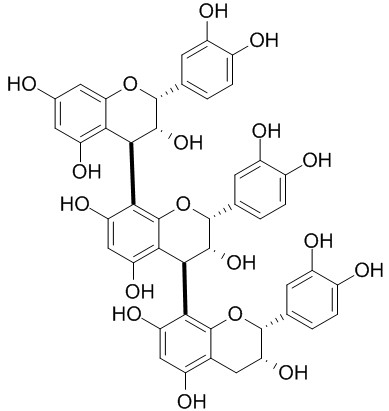Natural Products
Procyanidin C1
| Catalog No. | CFN99560 |  |
| CAS No. | 37064-30-5 | |
| Molecular Weight: | 866.77 | |
| Molecular Formula | C45H38O18 | |
| DBs | [PubChem]:274950593 [ChEMBL]:75643 [PCIDB]:9098 |
Standard InChI:
InChI=1S/C45H38O18/c46-18-10-27(54)33-32(11-18)61-42(16-2-5-21(48)25(52)8-16)39(59)37(33)35-29(56)14-30(57)36-38(40(60)43(63-45(35)36)17-3-6-22(49)26(53)9-17)34-28(55)13-23(50)19-12-31(58)41(62-44(19)34)15-1-4-20(47)24(51)7-15/h1-11,13-14,31,37-43,46-60H,12H2/t31-,37-,38+,39-,40-,41-,42-,43-/m1/s1
Biological Activity
In vitro, procyanidin C1 (PC1) dose-dependently decreased Fc epsilon RI-mediated degranulation and cytokine production of mast cells, inhibited tyrosine phosphorylation of Syk and linker for activation of T cells, and the ROS generation in stimulated mast cells.PC1 suppresses Fc epsilon RI-mediated mast cell activation by inhibiting intracellular signaling pathways, These observations provide evidence for the anti-allergenic effects of the procyanidin-enriched apple extract.[1]
Procyanidin C1-induced vasorelaxation is associated with the activation of the calcium-dependent NO/cGMP pathway, involving potassium channel activation, thus, it may represent a novel and potentially therapeutically relevant compound for the treatment of cardiovascular diseases.[2]
Procyanidin C1 is the main active compound in the CC extract responsible for EMT inhibition and that procyanidin C1 could be useful as a lead compound to develop inhibitors of cancer metastasis and other diseases related to EMT.[3]
Procyanidin C1 has anti-inflammatory effects, can inhibit IKKb activity in vitro and reduce the LPS-induced production of ROS, thus, it exerts the anti-inflammatory effects by inhibiting ERK1/2 and IKKb activity.[4]
Product
References
[1] Nakano N, Nishiyama C, Tokura T, et al. Int Arch Allergy Immun, 2008, 147(3):213-21.
[2] Byun E B, Sung N Y, Yang M S, et al. J Med Food, 2014, 17(7):742-8.
[3] Kin R, Kato S, Kaneto N, et al. Int J Oncol, 2013, 43(6):1901-6.
[4] Terra X, Palozza P, Fernandezlarrea J, et al. Free Rad Res, 2011, 45(5):611-9.
[5] Li M, Guo Q, Zhang X. J Pharm Analysis, 2015 (04): 644-8.
Product Use Citation





